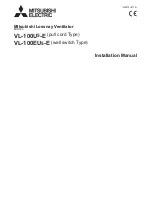
- 5 -
Unit Check Points:
___ Power connected, no ventilation call - Both fans are
off, frost control damper (if equipped) closes off
fresh air from outside.
___ Power connected, low speed call - Both fans on low
speed, internal frost control damper (if equipped)
opens fresh air from outside. If equipped with recir-
culation module, the internal frost control damper
closes recirculation opening.
___ Power connected, high speed call - Both fans on
high speed, frost control damper opens fresh air
from outside. If equipped with recirculation module,
the internal frost control damper closes recirculation
opening.
___ Power connected, occupied timer/sensor connec-
tion open (unoccupied mode) - Both fans are off,
frost control damper closes fresh air from outside. If
equipped with recirculation module, the internal frost
control damper opens recirculation opening.
___ Power connected, FF control contacts close during
unit ventilation or frost control cycle.
Frost Control
The unit functions are controlled by integrated controls
in the unit which may include Exhaust Only Defrost or
Recirculation Defrost (via the recirculation module - 600
cfm and 1200 cfm units only). In cold temperatures, frost
control cycles will remove frost from the heat exchanger
to maintain good operation.
Exhaust Only Defrost
(Optional)
Frost removal occurs when the supply blower de-ener-
gizes, the supply air damper and the heat exchange
damper close and the exhaust fan continues to circulate
only warm inside air through the flat plate heat exchang-
er to maintain ventilation. This process prevents the build
up of ice in the heat exchanger. Frost control is tempera-
ture initiated at 23°F to -22°F [-5°C to -30°C] and time
based.
Recirculation Defrost Module
The Recirculation Defrost Module is only available with
the 600 cfm and 1
15
0 cfm units. The frost control cycle is
electronically controlled in response to the outside
temperature 23°F to -22°F [-5°C to -30°C]. On a call for
frost control, the supply air damper in the recirculation
module closes, exhaust fan is de-energized and the sup-
ply fan continues to recirculate warm air through the flat
plate heat exchanger. It is possible to extend the frost con-
trol times during very cold weather by removing the jumper
JU1-F on the circuit board. For dimension and weight
changes to the 600 cfm and 1
15
0 cfm models with the
recirculation defrost module, see Appendix B-2 and B-4.
Remote Wall Control
(Optional)
Remote mounted wall control options are solid state
controls that can be used to control the ventilators from a
remote location. The connection from the ventilator to the
control is low voltage and requires a 4 conductor (24
gauge minimum) LVT cable. Models are available with a
dehumidistat control and speed switching. The following
three options are available:
Standard Wall Control
Dehumidistat to engage high speed exchange. Slide
switch operation supporting continuous low exchange
and continuous high exchange.
Xtra Wall Control
Dehumidistat to engage high speed exchange.
Electronic push button operation supporting intermittent
(stand-by) ventilation, continuous low exchange, continu-
ous high exchange, maintenance indicator light and
exchange indicator light.
AquaAir Wall Control
Ideal for pool dehumidification. Dehumidistat to engage
high speed exchange. Electronic push button operation
supporting intermittent (stand-by) ventilation, continuous
low exchange, continuous high exchange, maintenance
indicator light and exchange indicator light.
Airflow Measurement and Balancing
Once installation is complete, the supply and exhaust
airflows should be balanced to ensure proper operation
and a good quality installation. A well designed duct
system with properly sized duct runs and equal static
pressure losses of both the supply and exhaust will aid in
balancing the unit. However, it will be necessary to take
flow measurements with the proper equipment to ensure
a balanced system. Magnehelic gauges and Flow
Measuring Stations (FMS) are available for 14" x 8" [356
x 203mm] or 20" x 8" [508 x 203mm] rectangular duct and
a range of round duct sizes. Please ask your supplier for
more information.
Flow Station Positions
Whether flow stations are permanently installed or used
temporarily, the position they are placed in is very impor-
tant to ensure accuracy as shown in Appendix C. The
best locations for mounting the FMS is in the long straight
sections of ducting where airflow has stabilized across
the area of the duct. This position will provide the most
accurate measurements.
The next best location for the FMS is immediately
before or after a 90 degree elbow and 12" [305mm] from
any damper. In straight sections of pipe, the FMS should
be installed at least 30" [762mm] from any fan outlet. This
applies to the "Supply Air Opening" connection on the
heat recovery ventilator and the "Exhaust Air Opening"
connection.
WARNING
A negative building pressure may develop during the
frost control cycle with possible backdrafting fumes from
combustion equipment.






































